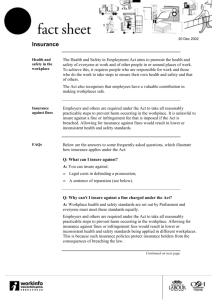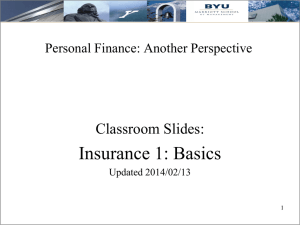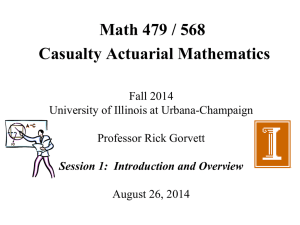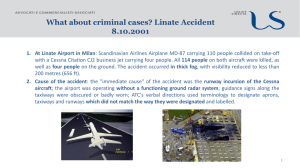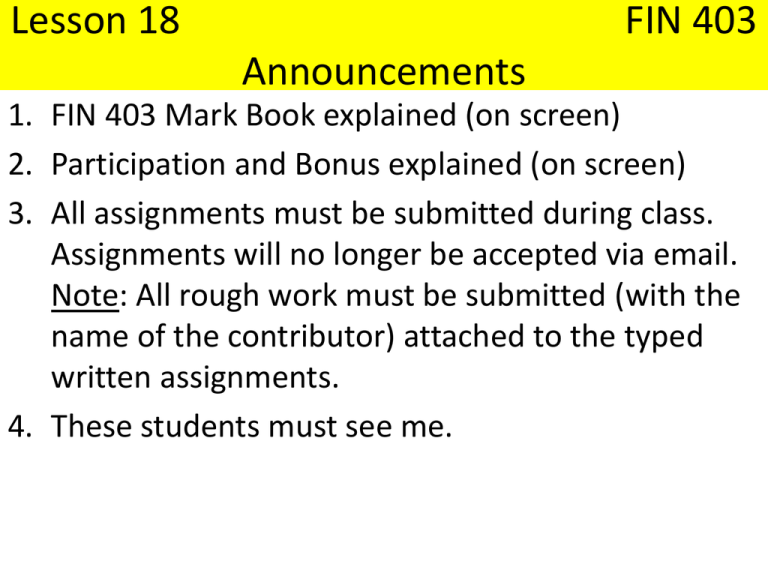
Lesson 18
FIN 403
Announcements
1. FIN 403 Mark Book explained (on screen)
2. Participation and Bonus explained (on screen)
3. All assignments must be submitted during class.
Assignments will no longer be accepted via email.
Note: All rough work must be submitted (with the
name of the contributor) attached to the typed
written assignments.
4. These students must see me.
5. Exam take up (partial)
6. Lesson.
FIN 403 Mark Book
Step 2 Evaluating the Risk
Step 1 listed the important risks.
Step 2 will evaluate using TWO CRITERIA.
a) The size of the potential loss.
b) The frequency or probability of occurrence.
Question: Which risks can you accept?
Which risks can you not accept?
Answer: These are personal decisions.
Insupportable Risks
A risk is not worth taking (is insupportable) if it
materially (financially) affects a family’s standard
of living.
If the loss causes us to suffer, at the expense of losing
an acceptable standard of living, we must insure
the risk.
Question. Can you give an obvious example of an
unsupportable risk?
Answer. See the screen.
Life. Property. Describe the Process.
Large versus small losses
Question. Is the theft of a 100,000 RMB car a big loss or a small
loss? (supportable or insupportable).
Some people can afford to replace that, while other can not.
The factors involved in making the decision include,
a) is my insurance rate (premium) very high so I will only insure
for damage caused to others and not the replacement of my
car?
What would you do?
b) Is my car worth so little that nobody is likely to want to steal
it and if it gets destroyed in an accident, the cost of the
premium over 10 years is more than I would pay to replace
it?
What would you do?
What is the probability of the risk occurring?
How likely is,
a) Your home to be destroyed by an earthquake, a
tornado or hurricane
b) Your home to be damaged by a wind storm
c) Your car to be seriously damaged in an accident
d) Your home to robbed and you lose your television,
computer and jewelry
e) A fire to destroy your garage
f) You to be seriously injured and be unable to earn a
living
g) You to die
How much will these things cost to replace (home,
toys, life)? (This is where you use your notebook and write down the examples of
replacement costs versus the cost to insure the items)
Home: $150,000
Garage: $50,000
Car: $15,000
Television: $800 Computer: $1,000 Jewelry: ???
Life: Lost earning that would support family
Disability: Lost earning…
Step 3
Controlling the Risk
Question: How can you control Risk?
Avoidance: you can avoid injuring yourself in a
dangerous sport by not playing that sport.
Example: Sky diving, hockey, karate, boxing, deep
sea scuba diving, alligator wrestling, race car
driving.
Separation: Parents who travel on different airplanes
will not be killed in the same accident, leaving the
children without financial support. Parents who
work for the same company risk losing their jobs
and income stream if the company goes bankrupt.
Prevention or Reduction of Frequency
Prevention or Reduction of Frequency is the most
useful way to minimize risk.
Examples include:
a) Eat healthy food and exercise frequently
b) Protect property with smoke detectors, cameras to
deter thieves, bolt locks on doors, locks on
windows, preventative maintenance on all
property (indoor and outdoor)
c) Drive your car carefully
d) Incorporate your family business
Refer back to Tenant Incident Reports.
Step 4
Financing the Risks
Question. What is meant by the statement,
“Insurance is based on the law of large numbers”.
If the occurrences of some event are independent of
each other, in a large population, the probability of
their occurring can be represented by the average
observed frequency.
Question. Name an example.
Answer. Slipping on these stairs. Car accident. One
occurrence does not cause another.
Financing the Risks
Question. Why is it so important to keep track of
accident occurrences? Example: Tenant Incident
Reports.
Answer. If the premiums collected add up to more
than the predicted cost to replace or repair the
particular damage, the population can share the
risk (of an insupportable loss). If the cost to
replace or repair is more than people are able to
pay in insurance premiums, the risk is not
insurable.
Financing the Risks
Question. What is an example of a risk that private
insurance companies are not willing to take but
governments are willing to take?
Answer. Government funded Employment Insurance.
Society shares the risk by allowing the government to
tax us and make payments to people who lost their
jobs, if the loss was not their fault.
Employment Insurance is a form of WELFARE.
Employment Insurance in Canada has payment
limitations which are approximately 50% of a
$40,000 salary.
Financing the Risks
Question. What kinds of risks that are so expensive to insure,
that private insurance companies will not offer insurance
coverage?
Answer:
Damage caused by war (foreign invasion)
Nuclear attack
Terrorism
In some geographical locations, earthquakes
Health – if there is a pre-existing condition.
Other things to know about…
Moral Hazards are not insurable. They occur when the
loss is due to deliberate (intentional actions or choices)
of the insured.
Self Insurance is not insurance but is a decision to not
finance a risk. A family may not insure a risk because
the loss may not negatively affect their standard of
living OR, they may not have enough money to pay for
the insurance and must take the chance that they will
not suffer the loss.
Example. A retired person does not have enough money
to insure their home. If they spent their money on
insurance, they would only have enough money for 10
months of food. If they own their home, they can make
the choice to not insure.
Example
Pooling Funds to insure an insupportable risk.
A town has 1000 homes and each home owner pays $500 for
one year of home insurance (fire, liability and theft).
1000 * $500 = $500,000
The observed frequency of fires, liability costs and thefts comes
to $350,000 in payouts annually for the insurance company.
The cost to run their business is $50,000. The owners of the
insurance company will earn a profit and the insured people
will be protected if the frequency of occurrences does not
increase to the point that the amount collected (including
company profit) is less than the amount collected in
premiums.
In Class Exercise: Do the math on a piece of paper in front of you
now and when you are done, hold it up for me to see.
Do it now.
When does pooling for insurance not work?
Insurance does not work when the incidents are
related to each other.
If the incidents are related in some way, then the
probability is not stable, since the existence of
some occurrences increase the probability of more
of them.
Question: What are the reasons that insurance
companies do not insure against job loss?
In class exercise: Maximum group size is 4 people
Read paragraphs 3 and 4 on page 193 starting with
“This pooling or insurance only works under some
conditions….
Answer the question (above ~ in red) and give your
own examples.
NOTE: A summary of the paragraph will not earn
bonus or participation marks. You must think and
give real life examples. Hand in your work before
you leave class today. Those that need to
additional work to earn bonus marks will be
returned in one or two classes.
Old Age Pension is a form of
Insurance and Welfare
The money for old age pensions must come from the citizens
who pay for it. The government budgets for it and must
know how much will need to be available in future years.
They must begin making the investments to pay for those
expenses long before they are paid out to retired persons.
A life table is a concise way of showing the probabilities of a
member of a particular population living to or dying at a
particular age. Life tables are used to examine the
mortality (DEATH) changes in the population over time.
Actuarial Tables
Actuarial Tables show the probability that an event
will occur, under every possible combination of age,
sex, occupation, etc.
Mortality Tables show the probability of death for
many different lifestyles and occupations, sex, etc.
Examples: men vs. women, smokers vs. non-smokers,
factory workers vs. office workers vs. coal mine
workers vs. every other type of employment ALSO
people of different nationalities, colours, ethnic
backgrounds…
Actuarial Society of Hong Kong
Careers in Risk Management
Actuaries put a price tag on future risks. Actuaries
have been called financial engineers and social
mathematicians because their unique combination
of analytical and business skills helps to solve a
growing variety of financial and social problems.
Actuaries make financial sense of the future. An
actuary applies mathematical models to problems of
insurance and finance.
Actuaries improve financial decision making by
developing models to evaluate the current financial
implications of uncertain future events.
Step 5
Monitoring the Risk
The risks that you face will change as you move through
your life cycle.
Question: What are some examples of life cycle events
that would effect your estimation of the risks in your
life?
Answer: Marriage, birth of a child, marriage breakup,
children becoming independent, retirement, death of
a spouse.
Annual Reviews of your budget, insurance coverage and
the changing risks around you should be an annual
task.
Summary
1. The 5 Steps of Risk Management: Identification,
evaluation, control, financing and monitoring.
2. Evaluation of risk should be based on possible
losses and the probability of the loss occurring.
3. Risk is managed with control techniques or
financed using insurance.
4. Your risk profile should be reviewed annually,
adjusting it based on changes in your life cycle.

